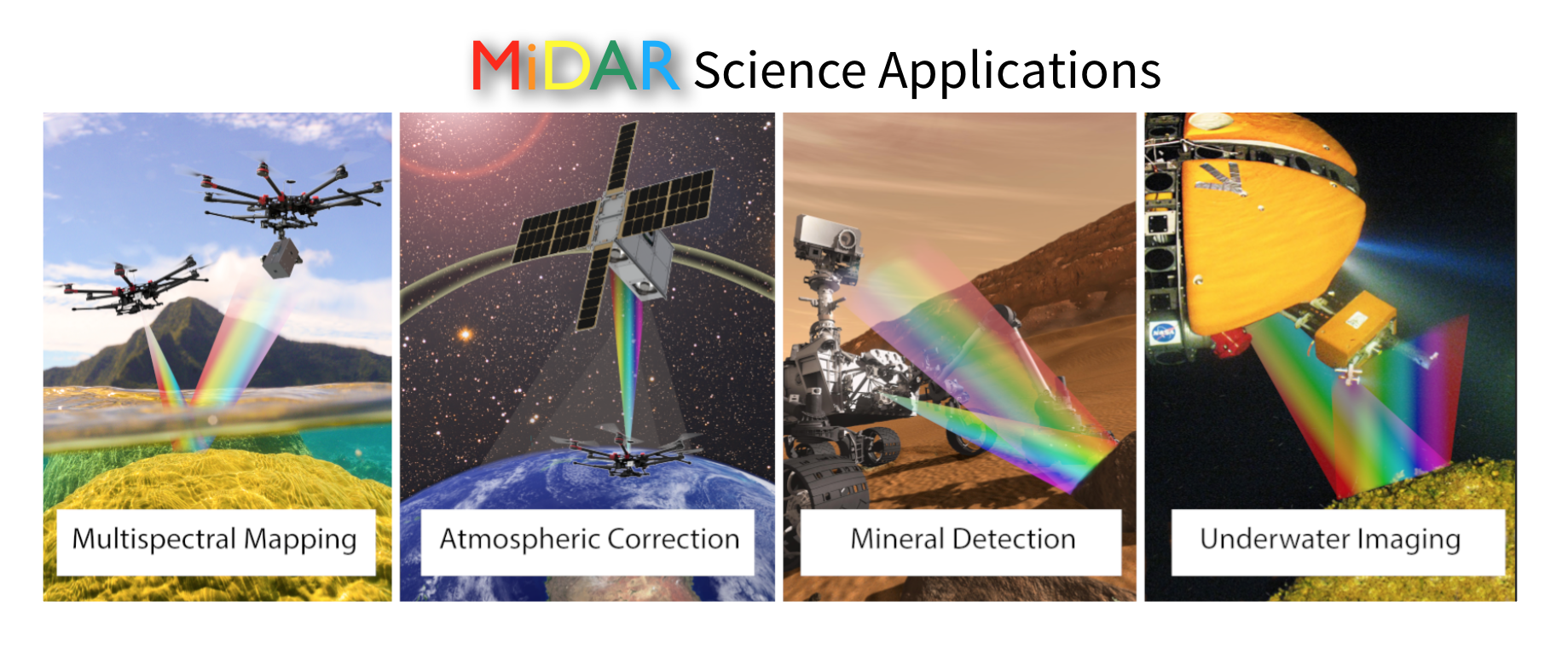MiDAR – Active Multispectral Imaging
A next-generation remote sensing technology with advanced scientific capabilities
MiDAR is a next-generation remote sensing instrument that provides real-time multispectral video using an array of LED emitters coupled with NASA’s FluidCam Imaging System. This instrument is currently under development with a NASA CIF 2015, 2016, & 2017 as well as NASA Innovation Fair grants, patents pending. MiDAR will enable active Fluid Lensing for multispectral imaging from remote sensing platforms. A MiDAR-integrated multipsectral mapping system is currently under development using standard commercially available small unmanned aerial systems (sUAS). Both the transmitting and receiver systems work in-tandem to reconstruct a multispectral image from an illuminated target.
MiDAR Summary
Principal Investigator: Ved Chirayath
We present a novel remote sensing technique and instrument for Multispectral Imaging, Detection and Active Reflectance (MiDAR) with next-generation scientific capabilities for simultaneous in-situ, airborne and spaceborne measurements and optical communications. MiDAR consists of an active optical transmitter and passive receiver in monostatic and bistatic configurations. The MiDAR transmitter emits coded narrowband structured illumination to generate high-frame-rate multispectral video, perform real-time radiometric calibration and provide a high-bandwidth simplex optical data-link under a range of ambient irradiance conditions, including darkness. A theoretical framework, based on unique color band signatures, is developed for multispectral video reconstruction and optical communications algorithms used on MiDAR transmitters and receivers. Experimental tests demonstrate a 5-channel MiDAR prototype consisting of an active array of multispectral high-intensity light-emitting diodes (MiDAR transmitter) coupled with a state-of-the-art, high-frame-rate NIR computational imager, the NASA FluidCam NIR, which functions as a MiDAR receiver.
Preliminary results confirm efficient, radiometrically calibrated, high signal-to-noise ratio (SNR) active multispectral imaging in 5 channels from 405-940 nm at 2048×2048 pixels and 30 Hz. These results demonstrate a cost-effective and adaptive sensing modality, with the ability to change color bands and relative intensities in real-time, in response to changing science requirements or dynamic scenes. Finally, we discuss potential applications of MiDAR including high-resolution nocturnal and diurnal multispectral imaging from air, space and underwater environments as well as long-distance optical communication, bidirectional reflectance distribution function characterization, mineral identification, atmospheric correction, UV/fluorescent imaging, 3D reconstruction using Structure from Motion (SfM) and underwater imaging using Fluid Lensing. Multipurpose sensors, such as MiDAR, which fuse active sensing and communications capabilities, may be particularly well-suited for mass-limited robotic exploration of Earth and the solar system and represent a possible new generation of instruments for active optical remote sensing.
Provisional Patent Filed April 5, 2016 by NASA Ames, ARC-17697-1. Full patent application filed 2016. Peer-reviewed technical paper coming soon (2017).
Credits: NASA Ames Lab for Advanced Sensing































